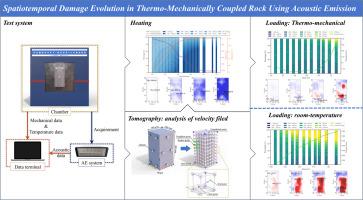基于声发射的热-力耦合岩石损伤时空演化研究
IF 9.4
1区 工程技术
Q1 ENGINEERING, MECHANICAL
International Journal of Mechanical Sciences
Pub Date : 2025-09-27
DOI:10.1016/j.ijmecsci.2025.110893
引用次数: 0
摘要
深层地质工程在理解热-力耦合作用下储层岩石各向异性损伤演化的力学机制方面面临着巨大挑战,这直接影响到工程的安全和经济效益。采用主被动声发射(AE)层析成像技术,研究了120°C单轴压缩条件下花岗岩的实时热-力耦合力学行为和损伤演化过程。结果表明:在温度高达67℃时,热膨胀使局部区域的初裂纹闭合,从而提高了波速,同时在其他区域引起热裂纹,导致材料变弱。热裂缝网络延长了应力重分布阶段,促进了三维断裂面的形成,从而显著降低了岩石破坏的风险。为了解决传统声发射参数对高温损伤敏感性有限的问题,本研究引入了环衰能量比(RER)。RER揭示了明显的前兆破坏信号,包括高温试样的连续下降和室温试样的突然增加,从而证明了它作为岩石热力学破坏的可靠指标的潜力。时空速度场分析进一步揭示了热裂纹扩展优先发生在低孔隙率区域。研究还发现了裂纹闭合阶段的主导扩展速率、弹性变形阶段衰减速率的显著增加以及裂纹扩展阶段的次级速度增长模式。这些发现阐明了深部岩体在热-力耦合作用下的损伤机理,为深部岩体的动态监测提供了方法。本文章由计算机程序翻译,如有差异,请以英文原文为准。

Spatiotemporal damage evolution in thermo-mechanically coupled rock using acoustic emission
Deep geological engineering presents substantial challenges in understanding the mechanical mechanisms driving anisotropic damage evolution in reservoir rocks under thermo-mechanical coupling, which directly impact engineering safety and economic efficiency. This study investigates the mechanical behavior and damage evolution of granite under real-time thermo-mechanical coupling at 120 °C during uniaxial compression, using active-passive acoustic emission (AE) tomography to examine the spatiotemporal damage mechanisms. The results indicate that thermal expansion causes the closure of primary cracks at temperatures up to 67 °C in localized regions, thereby enhancing wave velocity, while simultaneously inducing thermal cracking in other areas, which results in material weakening. The thermal crack network prolongs the stress redistribution phase and facilitates the formation of three-dimensional fracture surfaces, thereby significantly reducing the risk of rock failure. To address the limited sensitivity of traditional AE parameters to high-temperature damage, this study introduces the Ring-down to Energy Ratio (RER). The RER reveals distinct precursory failure signals, including a continuous decrease in the high-temperature specimen and abrupt increases in the room temperature specimen, thereby demonstrating its potential as a reliable indicator for thermal-mechanical rock failure. Spatiotemporal velocity field analysis further reveals that thermal crack propagation preferentially occurs in areas of low porosity. It also identifies a three-stage damage evolution pattern: dominant growth rate during crack closure, a significant increase in the attenuation rate during the elastic deformation stage, and secondary velocity growth during crack propagation. These findings elucidate the damage mechanism of deep rock masses under thermo-mechanical coupling and provide a dynamic monitoring approach.
求助全文
通过发布文献求助,成功后即可免费获取论文全文。
去求助
来源期刊

International Journal of Mechanical Sciences
工程技术-工程:机械
CiteScore
12.80
自引率
17.80%
发文量
769
审稿时长
19 days
期刊介绍:
The International Journal of Mechanical Sciences (IJMS) serves as a global platform for the publication and dissemination of original research that contributes to a deeper scientific understanding of the fundamental disciplines within mechanical, civil, and material engineering.
The primary focus of IJMS is to showcase innovative and ground-breaking work that utilizes analytical and computational modeling techniques, such as Finite Element Method (FEM), Boundary Element Method (BEM), and mesh-free methods, among others. These modeling methods are applied to diverse fields including rigid-body mechanics (e.g., dynamics, vibration, stability), structural mechanics, metal forming, advanced materials (e.g., metals, composites, cellular, smart) behavior and applications, impact mechanics, strain localization, and other nonlinear effects (e.g., large deflections, plasticity, fracture).
Additionally, IJMS covers the realms of fluid mechanics (both external and internal flows), tribology, thermodynamics, and materials processing. These subjects collectively form the core of the journal's content.
In summary, IJMS provides a prestigious platform for researchers to present their original contributions, shedding light on analytical and computational modeling methods in various areas of mechanical engineering, as well as exploring the behavior and application of advanced materials, fluid mechanics, thermodynamics, and materials processing.
 求助内容:
求助内容: 应助结果提醒方式:
应助结果提醒方式:


